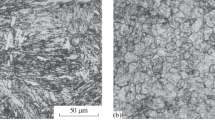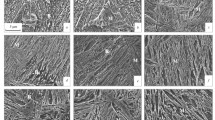Abstract
Special features of structure formation and mechanical properties of low-alloy martensitic steels with superequilibrium content of nitrogen and low content of carbon are considered. Experimental data on the effect of the temperature of heating for hardening and tempering on the structure, strength, and ductility of these steels are presented. The advantages and disadvantages of the introduction of nitrogen into low-alloy martensitic steels instead of carbon are discussed. It is shown that steel 10Kh3A combines high strength with high ductility. This steel is considered as a material for heavily loaded parts and nonwelded structures instead of high-strength steels alloyed with Ni, Mo, V and other expensive and scarce elements.
Similar content being viewed by others
REFERENCES
O. A. Bannykh, V. M. Blinov, and V. B. Proscurin, “On the structure and properties of high-nitrogen low-carbon non-austenitic steels,” Steel Res., 65(5), 178–183 (1994).
N. P. Liakishev and O. A. Bannykh, “New structural steels with superequilibrium nitrogen content,” J. Adv. Mater., No. 1, 81–91 (1994).
É. Gudremon, Special Steels, Vol. 2 [Russian translation], Metallurgiya, Moscow (1960).
Ts. V. Rashev, High-Nitrogen Steels Molten under Pressure, BAN, Sofia (1995).
Author information
Authors and Affiliations
Rights and permissions
About this article
Cite this article
Bannykh, O.A., Blinov, V.M. & Kostina, M.V. Structure and Properties of Low-Alloy High-Nitrogen Martensitic Steels. Metal Science and Heat Treatment 45, 43–48 (2003). https://doi.org/10.1023/A:1023952230778
Issue Date:
DOI: https://doi.org/10.1023/A:1023952230778




